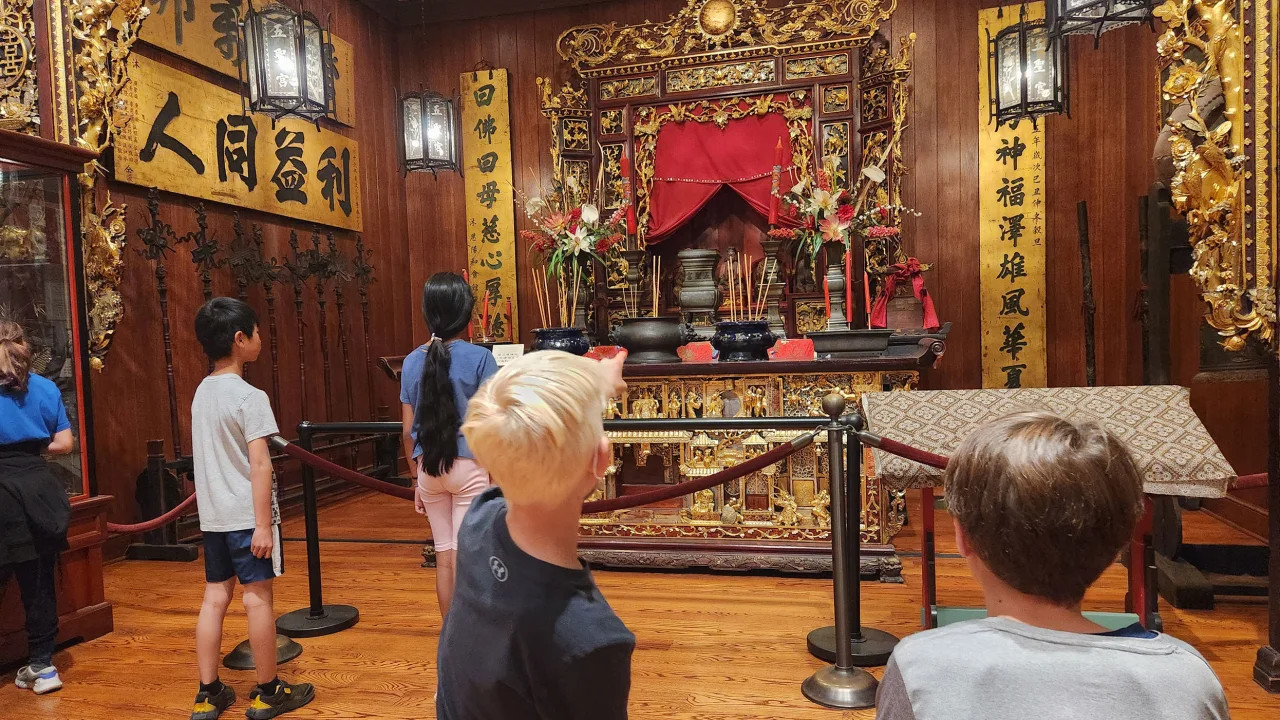
Fourth graders from Oak Avenue Elementary School are seen on a field trip at History San Jose. (Courtesy Emily Nakajima)
The following is an excerpt from 05/31/23 CNN:
By Natasha Chen
Tales of a fourth-grade field trip
“What is the one thing you can carry in your hand if you were fleeing your country?” Monica Pelayo Lock asked a group of fourth graders from Oak Avenue Elementary School in San Jose, California.
Lock, the director of education and community engagement at History San Jose, often takes school children through the city’s “History Park,” full of original and reproduction homes, business, and landmarks, complete with running trolleys and an old-fashioned ice cream shop.
The park includes several museums featuring the stories of Chinese, Vietnamese, Portuguese and Mexican immigrants to California, offering students as young as fourth grade a chance to learn about the wars, famines, and other factors driving people to emigrate from one place to another.
In answer to her question on a recent field trip, the 9- and 10-year-olds spat out answers including “an iPhone,” “money,” “clothing,” “food,” “water.” Then, they meandered through the various museums, looking at items like a real Vietnamese immigrant’s ID from the 1970s and artifacts dug up after an arson of San Jose’s Chinatown in the late 1800s.
“Everything I learned just now was new to me,” said 10-year-old Noa Kumayama. She told CNN she’s Japanese and felt empathy for the way Asian Americans were discriminated against throughout American history.
“I’m thinking, ‘oh, that’s never happened to me, thank goodness’…but I’m thinking ‘wow, what if that happened to me?’… a lot of people died,” she said.
Gerrye Wong, co-founder of the Chinese Historical and Cultural Project, often hosts these students in the Chinese American Museum at the History Park. Wong, who grew up in San Jose in the 1940s, was never taught anything about Chinese immigrants, or their contributions to California agriculture and railroads.
“I grew up with no knowledge of the discriminating (Exclusion Act) forbidding entry by Chinese sojourners to America. Neither my own children nor my grandchildren learned in their school studies about this history either. So finally, thanks to Gov. Newsom’s law on mandating studies in ethnic history…the new generation can grow up, learning about the early struggles and contributions of the Chinese settlers,” Wong told CNN.
Laura Kliewer, the Oak Avenue fourth graders’ teacher, said the children made connections between the history learned on this field trip with the struggles of today.
Students discussed how migrants are trying to cross the US Southern border today, for some of the same reasons people fled to the United States 150 years ago. Kliewer said the students also learned about the era of the Chinese Exclusion Act when Chinese immigrants were deemed “dirty” – and when asked if that has happened any other time, one of the students responded, “Covid-19.”

San Jose's History Park includes museums featuring the stories of Chinese, Vietnamese, Portuguese and Mexican immigrants to California. (Courtesy Emily Nakajima)
Kliewer has noticed a shift in her 25 years of teaching, which now includes more non-European perspectives. For example, when learning California history, as is required for all fourth graders in the state, her class has read aloud from a Native Californian’s experience at a Spanish mission. But teaching nuance to 9- and 10-year-olds is also important to her.
“I noticed my kids would sometimes be like, ‘Oh, they’re so bad!’ You know, and they try to label the Spanish as just being terrible. I also try to stop and say ‘wait, wait – were all of them bad? Could there have been some bad actors there? But they weren’t all bad.’ And so, in any story, you’re going to have people that were behaving poorly, and some people who are doing their best,’” Kliewer said.
In other states, parents, lawmakers and other groups have sometimes pushed back against studying ethnic histories, for fear that it would teach students that White people had been exclusively aggressors while others are perpetual victims.
But lessons of this field trip did not necessarily cast an entire group as a villain. In fact, Kumayama said when they learned about an arson that destroyed San Jose’s Chinatown, they also learned that a German man named John Heinlen braved death threats to lease property to the displaced Chinese.
Parent Julie Broms, whose 10-year-old son was on the field trip, said what her child is learning is much broader in scope than what she remembers of her own California elementary school education.
Broms said their school district has always been open to discussing all topics: “The more we can learn, the more informed we are. And so, I really appreciate where we live, and we’re able to have access to that knowledge.”
For more information: Read the full 05/31/23 CNN article.